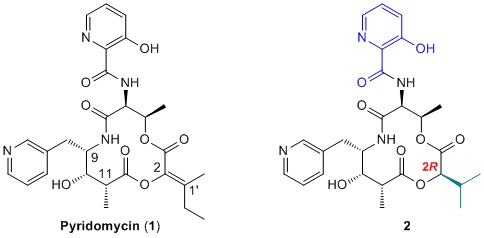Dihydropyridomycins as New Antitubercular Agents: Synthesis and SAR Studies
Pyridomycin (1) is a bacterial natural product that was first isolated in 1953 by Maeda and coworkers from the Streptomyces strain 6706.[1] The compound was shown to exhibit significant in vitro anti-tubercular activity (MIC = 0.3 µg/mL, H37Rv) and low cytotoxicity in mice.[1,2] The molecular target of 1 has recently been identified as the NADH-dependent enoyl-ACP reductase InhA, which is also the target of the clinically used anti-TB drug isoniazid.[2]

So far, only one total synthesis of pyridomycin (1) has been reported in the literature in 1989 by Kinoshita et al.,[3] mainly due to the difficult establishment of the enol-ester double bond between C2 and C1’. To overcome this difficulty, (S)- and (R)-2,1’-dihydropyridomycins were synthesized. Biological results showed that the dihydropyridomycin analog 2 retained most of the antibacterial activity of 1, while the corresponding 2S isomer was substantially less potent.[4]
Based on this initial finding, we have investigated variants of 2 with alternative alkyl substituents attached to C2 in an R configuration. Likewise, we have investigated dihydropyridomycin analogs where the hydroxypicolinic acid moiety was replaced by acyl residues incorporating different heteroaromatic structures. In addition, we have also prepared different analogs, one where a quinolinone group replaces the pyridine moiety in the C9 side chain and another with inversed stereocenters at C10 and C11. This contribution will discuss the synthesis of these new dihydropyridomycin derivatives and their InhA-inhibitory activity.
[1] Kenji Maeda, J. Antibiot. 6(3), 1953, 140.
[2] Ruben C. Hartkoorn, Claudia Sala, João Neres, Florence Pojer, Sophie Magnet, Raju Mukherjee, Swapna Uplekar, Stefanie Boy-Röttger, Karl-Heinz Altmann, Stewart T. Cole, EMBO Mol. Med. 2012, 4, 1032-1042.
[3] Mitsuhiro Kinoshita, Masaya Nakata, Kenji Takarada, Kuniaki Tatsuta, Tetrahedron Lett. 1989, 30, 7419-7422.
[4] Oliver P. Horlacher, Ruben C. Hartkoorn, Stewart T. Cole, Karl-Heinz Altmann, ACS Med. Chem. Lett. 2013, 4, 264-268.